Are you planning to spend a month traveling Vietnam but don’t know how much to budget for your trip? Maybe you have a rough idea about an average daily expense? Either way, are going to break down – in detail – our 1 month in Vietnam total cost by category for you to use as a reference.
Our budget and expense report will give you the perfect understanding of average costs for a couple traveling through Vietnam on a modest budget.
Being exposed to other travelers ideas about budgets and expenses are valuable resources that we are more than happy to provide. We will include areas we should have saved money in Vietnam, plus times we regret not pushing the boat out.
Budgeting is definitely one of the most difficult aspects of travel planning. It is almost impossible to know exactly how much you will spend. The key is to give yourself a big enough buffer to cover any eventuality.
Let’s begin.
One Month In Vietnam Travel Budget And Cost
The first thing we did was research. A lot of research! Some people love it and others hate it but research is key to efficient travel.
Not only is it cost effective as you pick up the best deals on flights and hotels, but thorough research also helps to make sure you do/see everything in a country.
We built up a picture of how much it would cost to travel for 1 month in Vietnam and calculated a target budget. Our rough estimate was a budget of around $3,000 (total for 2 people) for 30 days.
That worked out at $50 per day per person, which is a comfortable amount for Vietnam and would allow us room for the occasional splurge.
We broke down our travel expenses into the following categories:
- Flights
- Public transport
- Accommodation
- Food
- Activities or tours
- Miscellaneous
Further Reading: How To Plan A Trip In 15 Easy Steps
Every Traveler Is Different
Every person travels in their own style, spends more on certain things and less on others. We have our own travel cost quirks and we have learned over time they usually involve food or beer!
It wasn’t until we traveled long term that we realized how much we enjoyed food and in particular, food we were familiar with. As a result, we were surprised by how much we spent in total on eating out, even in Vietnam which is comparatively cheap.
Our expected costs were based upon a couple traveling somewhere between a low to mid-range budget. However, if you already know you will be traveling on a shoestring budget, you will have to spend less than we did each day.
On the other hand, if you have a healthy budget, you will be able to spend more on activities and stay in higher quality accommodation.
Each traveler will have their own preferred way of traveling and will allow more or less for certain indulgences. For example, which do you feel is more important for your budget: accommodation, food or activites.
Tips For Booking Vietnam Hotels
The resolute nemesis of any long term traveler – to book in advance or not to book in advance.
For Vietnam, our advice is simple:
If you don’t mind negotiating prices in person and booking day to day, do not book hotels / hostels in advance. Budget travelers will be better suited to this type of travel because it will save money.
However, if you prefer to have your itinerary complete so you don’t lose time when in Vietnam, book accommodation in advance. Travelers with a comfortable budget may also prefer the security of having rooms booked in advance.
But there is one important variable to consider, which season do you intend to visit Vietnam?
If you arrive in the high season, there will be less availability and far less chance of bartering a kick ass price at a hotel. Flip that over to low season and you stand an excellent chance of bagging yourself some real bargain prices for accommodation.
1 Month In Vietnam Cost Breakdown
Let’s take a look at the figures:
1. Flights To And From Vietnam
Flights in Vietnam and South East Asia offer fantastic value for all types of traveler. The key is to remain flexible on dates and times of day.
Internal flights are extremely affordable for those who prefer to fly or plan to travel longer distances within Vietnam. We only took 2 flights, one into Vietnam and one out at the end.
In Asia, we decided not to book anything in advance which has both pros and cons. Booking flights as you go is often less cost effective than booking in advance. Our flight prices weren’t enormous but they could have been much cheaper if we booked a few months or weeks ahead.
Here were the flights we booked:
- Inbound: Koahsiung, Taiwan to Hanoi
- Outbound: Da Nang to Bangkok, Thailand
Always check the baggage criteria for each airline. Sometimes they will be sneaky and charge more to check a bag than the flight itself.
There were a few times in South East Asia where an airline didn’t accept our Osprey Farpoint 40L backpacks as carry on because they had changed the dimensions criteria to personal item only.

Our 2 flights cost a total of $291 for 2 people accounting for just short of 10% of our estimated target budget of $3,000. This amounted to about US$ 150 per person.
$3000 – $291 = Targeted budget down to $2,709.
Our best advice is to book in advance for the cheapest flights and be flexible with your dates. Prior to booking you should also check the baggage criteria.
Further Reading: How To Book Cheap Flights Every Time
2. Public Transport
Depending on where you want to go, getting around Vietnam can be difficult. Infrastructure and facilities need improving if Vietnam intends on growing its tourist economy.
The long narrow country is most commonly traveled by train or sleeper bus. Personally, we chose to travel by sleeper bus because it was cheaper and more convenient over short distances.
We liked how the bus always took us directly to the next stop on our itinerary, whereas the train often required a bus or taxi transfer (such as Tam Coc, Phong Nha, Hoi An).
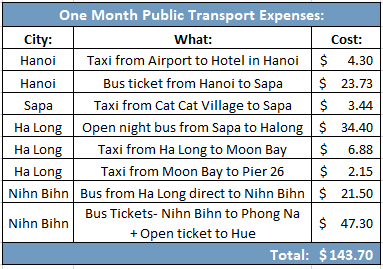
We were pleased with how low we kept transport costs in Vietnam. Sleeper buses can be hairy at times (read about sleeper buses here) but they provide incredibly cheap services offering unbeatable convenience.
We spent a total of $126.93 on buses which allowed us to see almost all of Northern and Central Vietnam. In addition, we spent a total of $16.77 on taxi’s.
One of those taxi’s was from Halong City to Halong Pier, which cost us $6.88 for a 5 mile ride. Compare that with the $21.50 bus from Halong Bay to Ninh Binh (Tam Coc), a 4 hour journey covering 135 miles.
Now, we all know taxi’s are more expensive than buses. But if you were to take a sleeper train from Hanoi to Halong Bay to Ninh Binh, you would need a taxi transfer to Tam Coc.
Same for Da Nang to Hoi An and Dong Hoi to Phong Nha. Those taxi’s/private cars/mini buses add up quickly.
$2,709 – $144 = $2,565 remaining.
Travel Tip: Buses are often the cheapest way to travel in Vietnam. We experienced good and bad buses so you may want to read reviews online prior to booking.
3. Accommodation
Accommodation is an area we just can’t help spending over the odds when compared to the typical travel on $25 a day in South East Asia guides.
That simply is not for us and we prefer to sleep in hotel rooms over dorms as a married couple. Plus, a double room can be cheaper or the same price as 2 dorm beds at times.
Accommodation is affordable in Vietnam and luxurious rooms aren’t too far out of even the most budget conscious travelers price range.
It’s all relative, you can spend the same on a crappy tiny room in London or Paris as you would for 5 star luxury room in Vietnam.
The challenge in Vietnam is not getting over excited by what your money can buy. To keep prices down, you have to quell that thirst for luxury even at those cheaper prices.
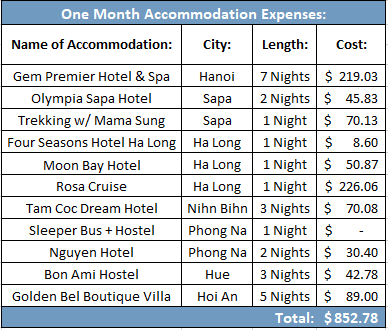
During our trip, we booked all our accommodation on booking.com or negotiated in person. Keep season in mind when traveling Vietnam – high, shoulder and low season changes as you travel North or South at different times of year.
We visited Vietnam in October, which is high season in the far North but rainy season as you approach Central areas.
Rainy season actually turned out to be a roasting hot season, but we still got great deals on accommodation in Phong Nha, Hue and Hoi An in Central Vietnam.
One of the mistakes we made was staying in Hanoi for 7 nights. In hindsight, we would have stayed somewhere else.
In our defense, it was partly to set up base for catching up with work but we spent $31 per night on a boutique hotel and could have easily shaved $10 per night.
$70 looks high in Sapa, but it also included 2 days trekking with guide.
We splurged in Halong Bay the night before our cruise but the hotel was lovely and we needed it after a killer overnight sleeper bus from Sapa to Halong. To balance, we took a cheaper but still amazing Halong Bay cruise.
$2,565 – $853 = US$ 1,712 remaining.
Further Reading: Best To Book Cheap Hotels For Travel
4. Food
Accommodation is an area we know we could save on if we really had to. Food, on the other hand, is one thing we can’t do anything about. Food and drinks are usually our highest cost category.
We love to try local food when we visit new countries and we always start out brilliantly. But there inevitably comes a breaking point for us and we revert back to what we are familiar eating.
What happens when you eat Western food in Vietnam? That’s right, you spend more money. A month is a long time to be eating one single type of food, no matter how good that food might be.
If you can do it, more power to you!
We also found striking a healthy balance between wellness and indulgence to be more difficult in Vietnam than anywhere else on our entire long term honeymoon around the world.
Although eating and drinking is far cheaper than you are used to, it all adds up!
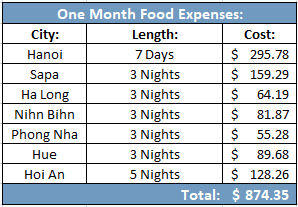
Almost $300 in 7 days in Hanoi looks astronomical but we ate at 3 high quality restaurants with friends and spent $74 just on drinks.
We also had a boozy Halong Bay cruise that totaled $51.
In Hanoi, we averaged $42 per day but compare that to $26 per day in Hoi An and $18 per day in Phong Nha. We could have saved at least $100 in Hanoi but made up for it elsewhere.
$1,713 – $874 = $839 remaining.
Travel Tip: Cut out western food and beer in Vietnam as much as possible if you are on a tight budget.
5. Activities And Tours
Every traveler in Vietnam has to sleep somewhere, travel between towns and eat food. The kicker is when you introduce excursions.
The volume and quality of activities and tours will be the ultimate factor on your cost for 1 month in Vietnam. These costs can quickly get out of hand.
For example, one night on a Halong Bay cruise can cost between $200-600. Likewise in Phong Nha, there are incredible looking adventure cave tours that can cost up to $3,000 per person.
If you choose to pay a Hanoi travel agency to book your 3 day 2 night Sapa tour including transport, expect to pay more than if you booked your own bus and Sapa trekking tour independently.
Tours and activities are where your Vietnam travel budget can go boom!
Deciding against paying for excursions is difficult because why have you bothered going somewhere if you’re not going to do the best things?!
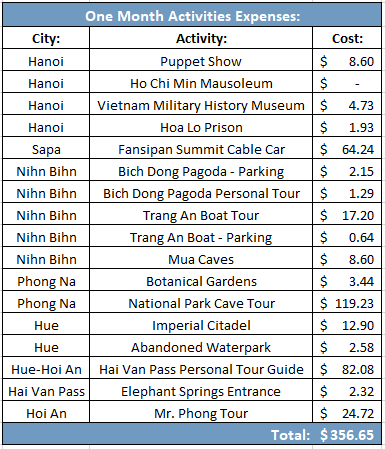
Our biggest expenses were:
- The Fansipan cable car in Sapa but totally worth the money
- Touring Paradise Cave and Dark Cave in Phong Nha which was a little overpriced but worth it for the convenience
- Our Hai Van Pass personal guide and bike hire which was worth every penny
The best value attractions were Mua Cave Viewpoint and Bich Dong Pagoda in Ninh Binh, Botanic Gardens in Phong Nha and abandoned water park in Hue.
The other Phong Nha adventure caves were something we would have splurged on if we had a few hundred dollars spare, but we didn’t. We regret that now.
$839 – $357 = $482 remaining.
Travel Tip: If you really want to experience something, try to make it happen with your budget. For example, we wish we cut costs on overall accommodation to explore a Phong Nha adventure cave.
6. Miscellaneous Costs
Miscellaneous expenses have a greater sting in the tail than a threatened scorpion.
There’s nothing worse than being led to believe that you’ve done really well with costs somewhere, only to discover that you forgot about the $10 laundry bill or $5 shampoo and conditioner replenishment.
Fortunately in Vietnam, miscellaneous costs can be kept to a minimum.
You won’t need to leave big tips after meals, there are no taxes on purchases, bike and moped rentals are extremely reasonable, but gas is cheap!
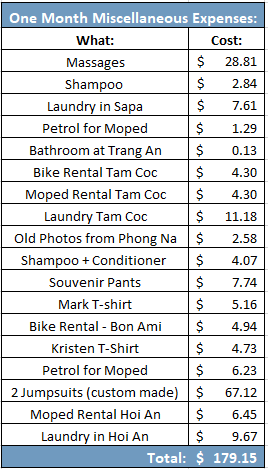
Massages were a cost we could have avoided but $28.81 for 2 separate one hour massages each is worth the splurge. We spent $28.46 on laundry which isn’t too bad for the entire month.
The majority of our miscellaneous costs were buying clothes, totaling $87.75. That includes 2 amazing tailored rompers for Kristen in stunning Hoi An.
$482 – $179 = $303 remaining.
Travel Tip: Overall it’s pretty easy to keep miscellaneous costs to a minimum in Vietnam.
Analysis Of Our Total Costs
Although we planned to spend the full 30 days in Vietnam, we ended up cutting it off by a few days at the end to make a total of 27 days.
We were in Hoi An, exhausted from non stop sightseeing and traveling.
Our original intention was to continue South to Da Lat and Ho Chi Minh City. But we found a flight from Da Nang to Bangkok and decided to tag on a couple of days in Hoi An as we loved the city, rather than rush the rest of Southern Vietnam.
This analysis represents 27 days of expenses, so we will take an average daily spend and add 3 of the daily average to the total to make a 30 day expense report.
Our total cost for 27 days was $2697.25. Therefore, our daily average spend was $99.89.
Add 3 x $99.89 to 2,697 representing the 3 remaining days to make the 30 day visa and our grand total cost for 1 month traveling Vietnam was $2996,92.
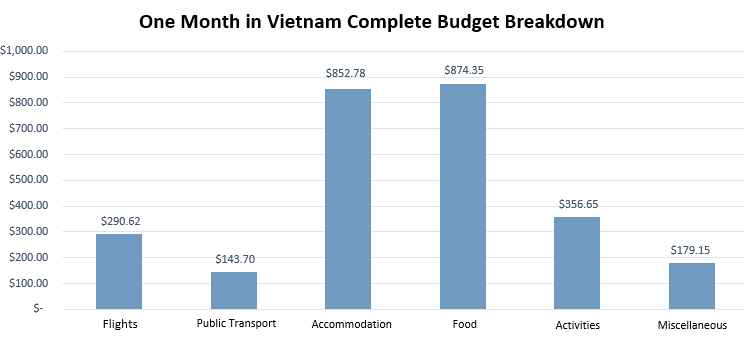
Right On Budget
We hit the nail on the head with our projected budget for Vietnam but in the end we weren’t sure whether to be pleased or a little disappointed.
We gave ourselves a big buffer for Vietnam and secretly expected to fall short of $3,000 but it’s easy in hindsight to see where you can save.
Looking at statistics is a great way to hammer home a point. We looked at our figures and knew we could have cut costs on food and drink.
We didn’t exactly chastise ourselves and say we must do better but we did pay closer attention to that area as our month in Thailand began immediately after Vietnam.
Some people will look at our statistics and think they are rookie numbers while others will grimace and think we’ve wildly overspent.
All we know is that we had an incredible experience.
The pie chart below hows how much each category cost us as a percentage of our overall projected budget for 1 month traveling in Vietnam.
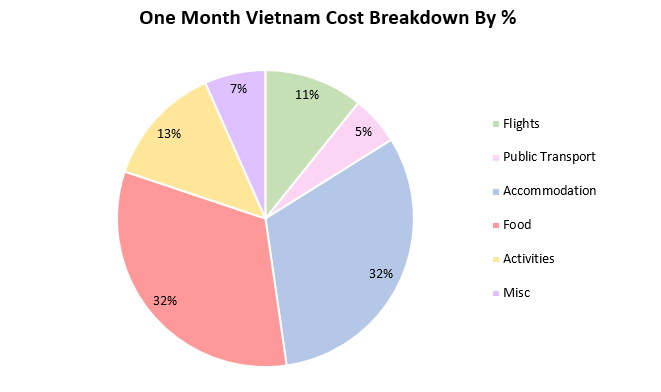
Popular Vietnam Guides
- Amazing places to visit in Vietnam
- Best things to do in Hanoi
- Fun things to do in Sapa
- How to book the best Halong Bay Cruise
- Cool things to do in Ninh Binh
- How to drive the Hai Van Pass
- Best things to experience in Phong Nha
- How to choose a Trang An Boat Tour
More Vietnam Guides
- How to travel between Hanoi and Halong bay
- Best way to get from Da Nang to Hoi An
- Why 2 days is enough time in Hanoi
- Guide to vsitiing Hang Mua Peak
- How to visit the Bich Dong Pagoda
- Complete guide to booking a guided hike in Sapa
- Guide to finding the Abandoned Waterpark in Hue
- An honest review about visiting Dark Cave in Phong Nha
- How to find the Botanic Gardens in Phong Nha
Want more Vietnam content? Head over to our Vietnam Travel Guides to see example itineraries, tips about Vietnam and popular city guides.
We hope our expense report will help you work our a rough idea of how much it will cost you to spend 1 month in Vietnam.
Please let us know if you have any questions about planning or budgeting for a trip to Vietnam in the comments below.
Happy Travels,
Mark and Kristen
Enjoy This Vietnam Budget Guide? Pin It For Later!
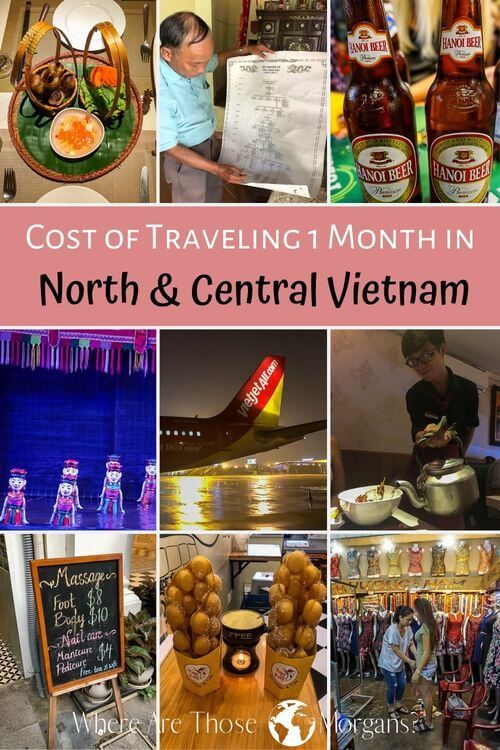
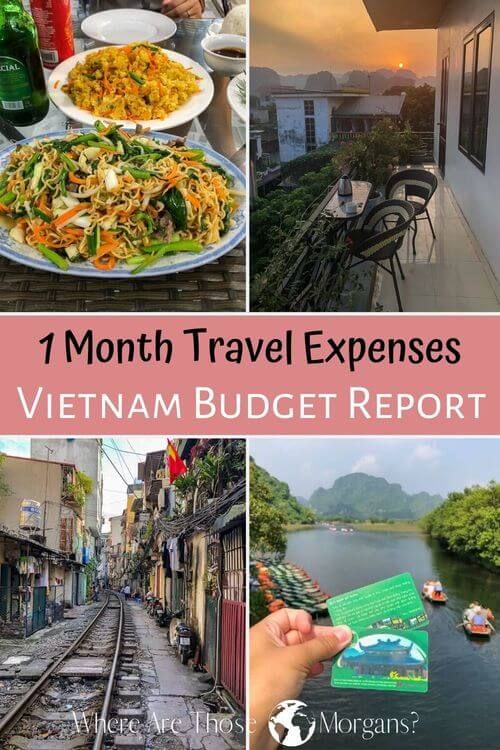
Note: This article contains affiliate links. When you make a purchase using one of these affiliate links, we may earn a small commission at no extra cost to you.
All Rights Reserved © Where Are Those Morgans, LLC. Republishing this article and/or any of its contents (text, photography, maps, graphics, etc.) in whole or in part is strictly prohibited.
Mark and Kristen Morgan are travel, hiking and photography experts. Over the last 6 years traveling full time, they have explored more than 40 countries and 30 US states.
Where Are Those Morgans has been featured in USA Today, Gestalten, Get Your Guide, CityPASS and Condé Nast Traveler along with various other publications. Read more about us.

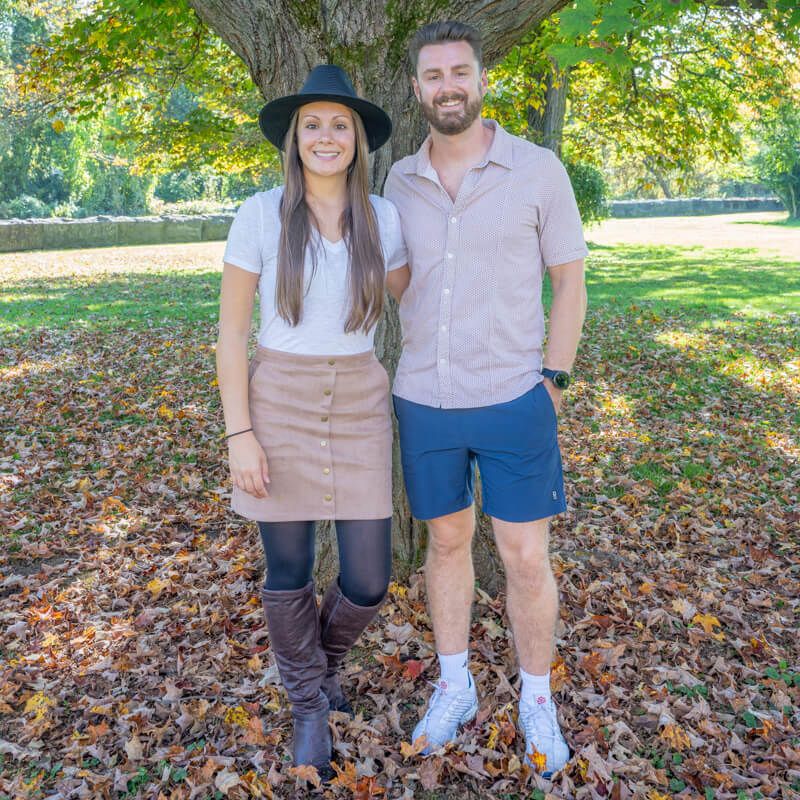

Hi. Very useful hints! Thank you, Wondering why spending seven nights in Hanoi would not be repeated? Too big a city? Boring? Or time spent better elsewhere. Janet
Hi Janet, Hanoi is great but you only really need 2 or 3 days at the most. Your time would definitely be spent better in more rural parts of Vietnam like Tam Coc and Phong Nha, or more quaint cities like Hoi An. Have a great trip!